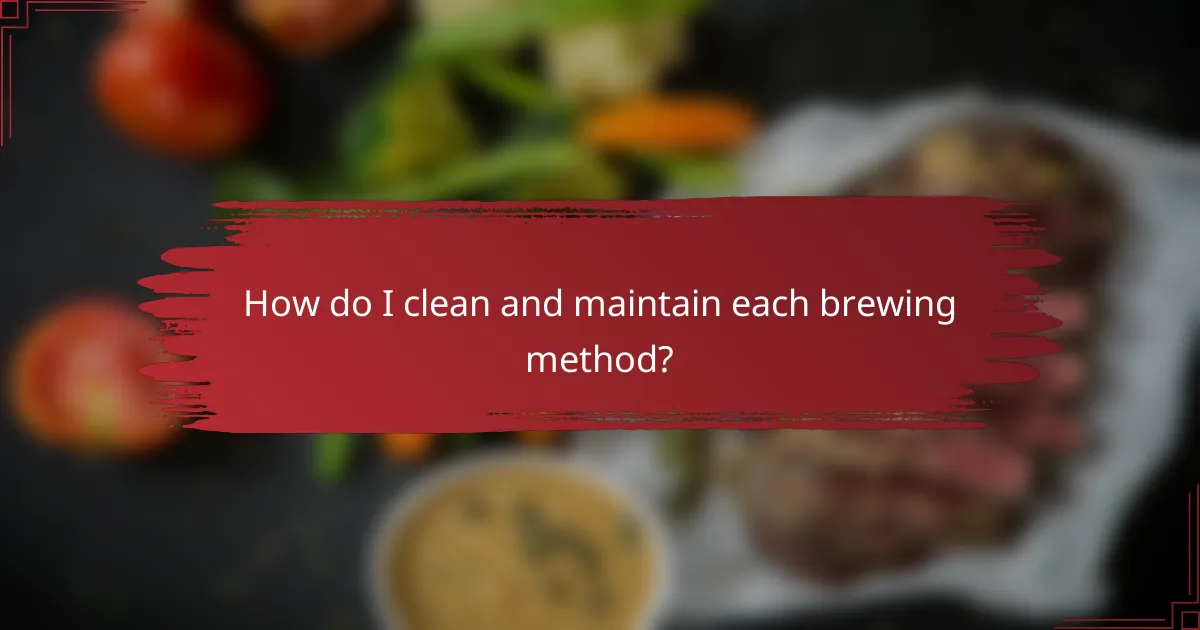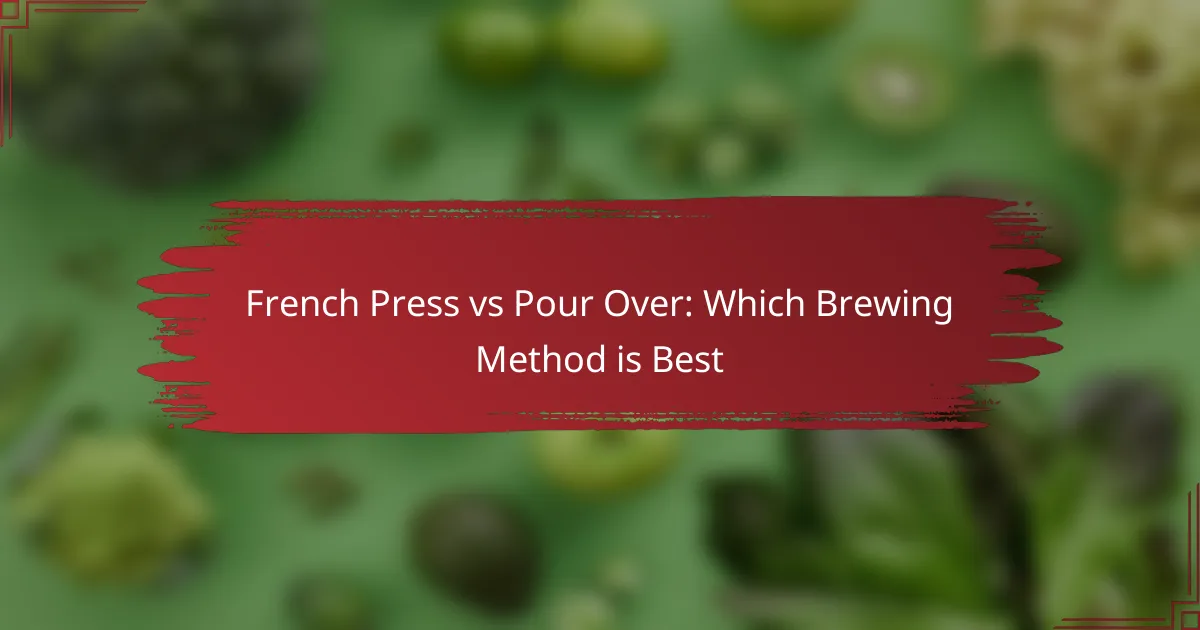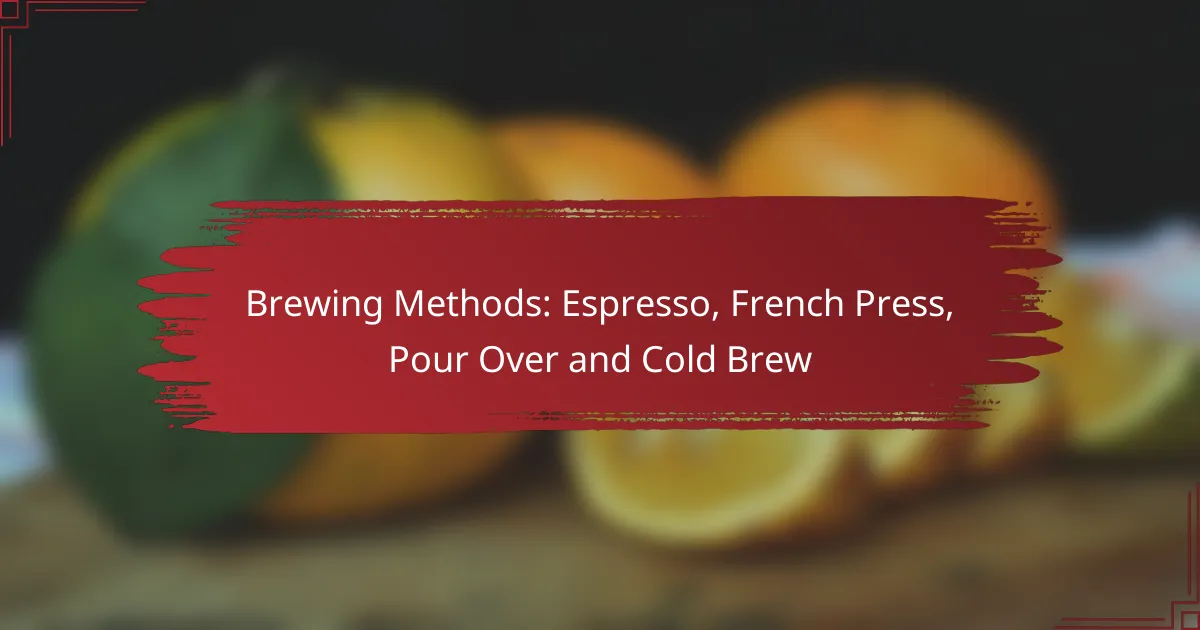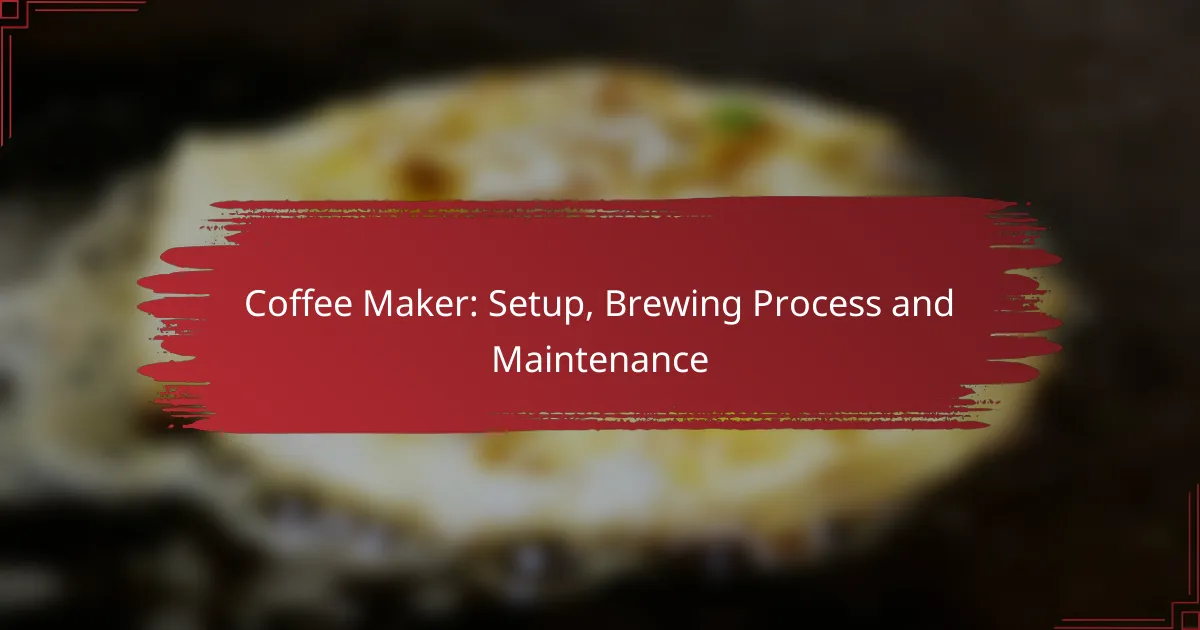When it comes to brewing coffee, the choice between French Press and Pour Over methods can significantly impact your experience. French Press is celebrated for its rich, full-bodied flavor, while Pour Over provides a cleaner, more nuanced cup with precise control over brewing variables. Ultimately, your decision should reflect your personal taste preferences and desired coffee characteristics.

Which brewing method is better for coffee lovers?
The choice between French Press and Pour Over brewing methods depends on personal taste preferences and desired coffee characteristics. French Press is known for its rich, full-bodied flavor, while Pour Over offers a cleaner, more nuanced cup with greater control over brewing variables.
French Press offers rich flavor
The French Press method involves steeping coarsely ground coffee in hot water for several minutes before pressing down a metal or plastic plunger. This process extracts oils and fine particles from the coffee grounds, resulting in a robust and full-bodied brew.
Many coffee lovers appreciate the bold taste that the French Press provides, making it ideal for those who enjoy a strong cup. However, the presence of sediment can lead to a gritty texture, which some may find unappealing.
Pour Over provides clarity and control
Pour Over brewing involves manually pouring hot water over coffee grounds in a filter, allowing for precise control over water temperature, flow rate, and extraction time. This method produces a clean and bright cup of coffee, highlighting the unique flavors of the beans.
With Pour Over, coffee enthusiasts can experiment with different variables to achieve their ideal brew. While it requires more attention and technique than French Press, the clarity and complexity of flavors often make it worth the effort for many coffee aficionados.

What are the key differences between French Press and Pour Over?
The French Press and Pour Over methods differ primarily in their brewing techniques and resulting flavor profiles. French Press typically produces a fuller-bodied coffee, while Pour Over offers a cleaner, more nuanced taste.
Brewing time varies significantly
Brewing time is a critical factor that distinguishes the French Press from the Pour Over method. French Press usually requires about 4 to 5 minutes to steep, allowing for a robust extraction of flavors. In contrast, Pour Over brewing times can range from 2 to 4 minutes, depending on the pour rate and coffee-to-water ratio.
When using the Pour Over method, the timing can be adjusted to achieve different flavor notes. A slower pour can enhance sweetness, while a faster pour may highlight acidity. Experimenting with these variables can help you find your preferred taste profile.
Grind size impacts extraction
The grind size of coffee beans plays a crucial role in both brewing methods, affecting extraction and flavor. For French Press, a coarse grind is recommended to prevent over-extraction and sediment in the final cup. A typical grind size is similar to sea salt.
On the other hand, Pour Over requires a medium grind, akin to granulated sugar. This size allows for optimal water flow and extraction during the brewing process. Using the correct grind size for each method is essential to achieving the desired flavor and clarity in your coffee.

How do I choose between French Press and Pour Over?
Choosing between French Press and Pour Over depends largely on your flavor preferences and brewing habits. Each method offers distinct characteristics that can enhance your coffee experience, so consider what matters most to you.
Consider your taste preferences
The French Press typically produces a rich, full-bodied coffee due to its immersion brewing technique, which allows oils and fine particles to remain in the cup. If you enjoy a robust flavor with a heavier mouthfeel, this method may be your best choice.
On the other hand, Pour Over tends to yield a cleaner, more nuanced cup. This method allows for better control over brewing variables, which can highlight different flavor notes in the coffee. If you prefer a lighter, more delicate taste, Pour Over might suit you better.
Evaluate your brewing routine
Your brewing routine can significantly influence your choice. French Press is generally quicker and requires less precision, making it ideal for those who want a straightforward process. It typically takes around four minutes from start to finish.
Pour Over, while offering more control, requires a bit more time and attention. The process can take anywhere from two to five minutes, depending on your technique. If you enjoy the ritual of brewing and have the time to dedicate, Pour Over can be a rewarding experience.

What equipment do I need for each method?
To brew coffee using a French Press or Pour Over method, specific equipment is essential. A French Press requires a press and coarsely ground coffee, while a Pour Over setup involves a dripper and medium-fine ground coffee.
French Press requires a press and coarsely ground coffee
The French Press, also known as a press pot, consists of a cylindrical glass or stainless steel container with a plunger and a mesh filter. For optimal extraction, use coarsely ground coffee, typically around 1:15 coffee-to-water ratio, which translates to about 30 grams of coffee for 450 milliliters of water.
When using a French Press, be mindful of steeping time; aim for about four minutes. A common pitfall is pressing too early, which can lead to under-extraction and a weak flavor. Ensure the coffee grounds are evenly saturated for the best results.
Pour Over needs a dripper and medium-fine ground coffee
The Pour Over method uses a dripper, such as a V60 or Chemex, along with a filter to brew coffee. For this technique, medium-fine ground coffee is ideal, with a typical ratio of 1:16 coffee to water, meaning around 30 grams of coffee for 480 milliliters of water.
Pay attention to the pouring technique; a slow, circular motion helps evenly saturate the grounds. Avoid pouring too quickly, as this can lead to uneven extraction and a bitter taste. Experiment with different grind sizes and pouring speeds to find your perfect brew.

What are the costs associated with each brewing method?
The costs associated with French Press and Pour Over brewing methods can vary significantly based on equipment and accessories. Generally, French Press setups are more budget-friendly, while Pour Over systems can range widely in price depending on the complexity and brand of the equipment.
French Press is generally more affordable
A basic French Press can be purchased for as little as $15 to $30, making it an accessible option for many coffee enthusiasts. The simplicity of the design means that there are few additional accessories required, aside from a grinder and quality coffee beans.
Maintenance costs are also low, as French Presses are typically made from durable materials like glass or stainless steel. This longevity means that, over time, the investment remains economical compared to more complex brewing methods.
Pour Over can vary in price based on equipment
Pour Over setups can range from around $20 for a simple dripper to several hundred dollars for high-end models with integrated scales and temperature control. The price often reflects the quality of materials and the precision of the brewing process.
In addition to the dripper, users may need to invest in a gooseneck kettle, filters, and a scale for accurate measurements, which can add to the overall cost. While the initial investment may be higher, many enthusiasts find that the control and flavor precision justify the expense.

How do I clean and maintain each brewing method?
Cleaning and maintaining your French Press and Pour Over equipment is essential for optimal coffee flavor and longevity. Each method has its own specific requirements that should be followed to ensure a great brewing experience.
French Press requires thorough rinsing
To clean a French Press, start by disassembling the plunger and filter. Rinse all parts with warm water to remove coffee grounds and oils. It’s important to do this immediately after use to prevent residue buildup.
For deeper cleaning, use a mild detergent and a soft sponge. Avoid abrasive materials that could scratch the glass or metal surfaces. Regular cleaning every few uses will help maintain the quality of your coffee.
Pour Over needs regular descaling
Pour Over devices, especially those made from glass or plastic, require regular descaling to remove mineral buildup from water. This is particularly important if you use hard water, which can lead to a bitter taste in your coffee.
To descale, mix equal parts of water and white vinegar, and run it through the device as if you were brewing coffee. Rinse thoroughly with clean water afterward. Aim to descale every month or so, depending on your water quality and usage frequency.

What are the common mistakes to avoid?
Avoiding common mistakes in brewing methods like French press and pour over can significantly enhance your coffee experience. Key errors often include incorrect grind size, improper water temperature, and inaccurate brewing time.
Using the wrong grind size
The grind size of your coffee beans plays a crucial role in extraction. For French press, a coarse grind is ideal, while pour over requires a medium to medium-fine grind. Using the wrong size can lead to over-extraction or under-extraction, affecting flavor.
To avoid this mistake, invest in a good burr grinder that allows you to adjust the grind size easily. Experiment with different sizes to find the perfect balance for your preferred brewing method.
Incorrect water temperature
Water temperature is another critical factor in brewing coffee. For both French press and pour over, water should ideally be between 90-96°C (194-205°F). Water that is too hot can scorch the coffee, while water that is too cool may not extract the flavors effectively.
Use a thermometer or a kettle with temperature control to ensure you’re brewing at the right temperature. If you don’t have these tools, let boiling water sit for about 30 seconds before pouring.
Not measuring coffee and water accurately
Accurate measurements of coffee and water are essential for achieving a balanced brew. A common guideline is to use about 1 to 2 tablespoons of coffee per 6 ounces of water, depending on your taste preference. Not measuring can lead to overly strong or weak coffee.
Consider using a kitchen scale to measure your coffee and water precisely. This will help you replicate your favorite brew consistently.
Ignoring brewing time
Brewing time can significantly impact the flavor profile of your coffee. For French press, a steeping time of about 4 minutes is recommended, while pour over typically takes around 2-3 minutes. Oversteeping can lead to bitterness, while understeeping may result in a sour taste.
Use a timer to keep track of your brewing time. Adjust it based on your taste preferences and the specific characteristics of the coffee you are using.


